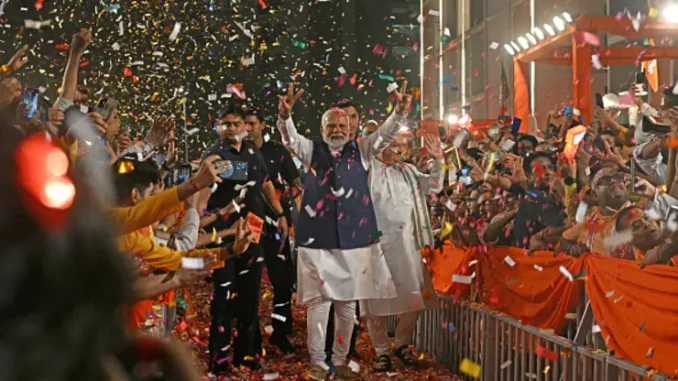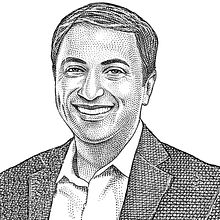
He expected a blowout, but his party lost more than one-fifth of its seats and its outright majority
“For the BJP, disappointment stems from inflated expectations. On the campaign trail Mr. Modi boasted that the BJP-led National Democratic Alliance aimed to win more than 400 seats this year. He also claimed that he had been sent by God to serve India. A flurry of exit polls released a few days before vote counting predicted that the BJP and its allies would win 350 to 400 seats. Most predicted that the opposition alliance would win fewer than 170 seats………………… That Mr. Modi barely scraped through with the help of allies marks a serious blow to the aura of invincibility he has cultivated since becoming prime minister in 2014. In the temple town of Varanasi in the northern state of Uttar Pradesh—Mr. Modi’s constituency—his victory margin over his closest Congress rival in this election shrank by more than two-thirds compared with the 2019 election. The BJP lost 29 seats in Uttar Pradesh, and another 14 in the state of Maharashtra.”

You might think that an almost-certain return to power for a third successive term after winning more than twice as many parliamentary seats as your nearest rival would be cause for celebration for any politician. Not if you’re Indian Prime Minister Narendra Modi. True, the ruling Bharatiya Janata Party and its allies are on track to form the next government. But by severely underperforming exit-poll predictions and his own hype, Mr. Modi appears diminished rather than exalted by this victory.
After counting 642 million votes, election officials reported that the BJP-led National Democratic Alliance had won 293 seats in the 543-seat lower house of Parliament. The BJP alone had won 240, a loss of 63 seats compared with the outgoing Parliament and well below the 272 seats needed for a single-party majority. The opposition Congress Party, which many pundits and pollsters had written off for months as a spent force, turned out its best performance in 15 years by winning 99 seats on its own. The Congress-led INDIA Alliance, a coalition of about two dozen parties, won 234 seats, by far the opposition’s best performance since Mr. Modi first rose to power in 2014.
For the BJP, disappointment stems from inflated expectations. On the campaign trail Mr. Modi boasted that the BJP-led National Democratic Alliance aimed to win more than 400 seats this year. He also claimed that he had been sent by God to serve India. A flurry of exit polls released a few days before vote counting predicted that the BJP and its allies would win 350 to 400 seats. Most predicted that the opposition alliance would win fewer than 170 seats. On paper the election seemed to favor a landslide for the ruling party. Mr. Modi’s high approval rating—74% in May, according to Morning Consult—makes him one of the world’s most popular democratically elected leaders. High-profile temple inaugurations, including one to the Hindu deity Ram in the temple town of Ayodhya in January, were supposed to cement the prime minister’s support among the roughly 80% of Indians who are Hindu.
The BJP has many advantages over its rivals. After a decade as the ruling party, it enjoys a massive fundraising edge. Much of the media, especially Hindi news channels, have a strong pro-BJP tilt. Before the elections, the Modi government jailed some prominent opposition leaders, including Delhi’s Chief Minister Arvind Kejriwal, for alleged corruption. A slew of defections from the opposition to the ruling party were expected to further strengthen the BJP. And the personality cult around the prime minister ensured that voters were continually reminded of his presence. At one point, Covid-19 vaccination certificates in India bore his image, and the ruling party last year portrayed a routine Group of 20 Summit as a global tribute to Mr. Modi’s leadership.
That Mr. Modi barely scraped through with the help of allies marks a serious blow to the aura of invincibility he has cultivated since becoming prime minister in 2014. In the temple town of Varanasi in the northern state of Uttar Pradesh—Mr. Modi’s constituency—his victory margin over his closest Congress rival in this election shrank by more than two-thirds compared with the 2019 election. The BJP lost 29 seats in Uttar Pradesh, and another 14 in the state of Maharashtra.
In a speech to party workers Tuesday night, Mr. Modi attempted to put a positive spin on a disappointing performance. He pointed out that his is the first Indian government to win three successive terms since Jawaharlal Nehru’s in 1962. More silver linings for the BJP: In state-level elections, the party won power for the first time in the eastern state of Odisha, and a BJP ally, the Telugu Desam party, won a substantial majority in the southern state of Andhra Pradesh. The BJP also significantly improved its vote share in the southern state of Tamil Nadu, and for the first time won a seat in neighboring Kerala.
How might a third Modi term differ from the first two? U.S.-India relations, driven by shared concerns about China’s ambitions, are unlikely to change.
The prime minister’s domestic agenda will depend on what lessons he draws from his humbling. If India is lucky, Mr. Modi will take a less heavy-handed approach toward his critics in the opposition and the media, and strike a more conciliatory tone toward Muslims, Christians and Sikhs who feel threatened by the excesses of Hindu nationalism. On the economic front, Indians should hope the prime minister continues to build infrastructure and rejects the Congress Party’s push to increase caste-based quotas in education and employment.
It’s uncertain which direction Mr. Modi will take. But one thing is clear: Indian voters aren’t as enamored with his strongman style and brassy overconfidence as he and his supporters assumed.
(Source: Bloomberg)





Be the first to comment